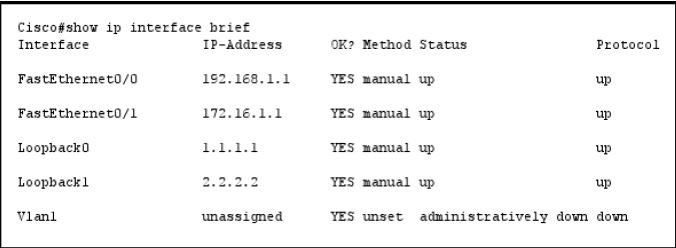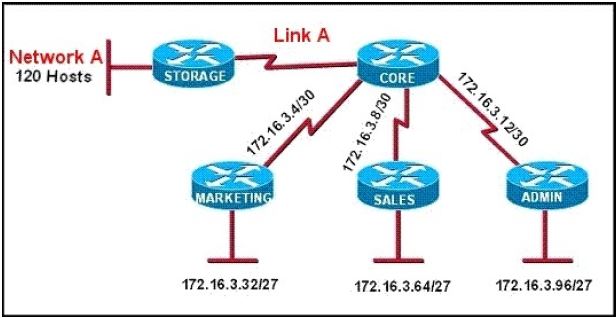Refer to the exhibit.

If the router Cisco returns the given output and has not had its router ID set manually, what value will OSPF use as its router ID?
A. 192.168.1.1
B. 172.16.1.1
C. 1.1.1.1
D. 2.2.2.2
Refer to the exhibit.

If the router Cisco returns the given output and has not had its router ID set manually, what value will OSPF use as its router ID?
A. 192.168.1.1
B. 172.16.1.1
C. 1.1.1.1
D. 2.2.2.2
What OSPF command, when configured, will include all interfaces into area 0?
A. network 0.0.0.0 255.255.255.255 area 0
B. network 0.0.0.0 0.0.0.0 area 0
C. network 255.255.255.255 0.0.0.0 area 0
D. network all-interfaces area 0
Which statement describes the process ID that is used to run OSPF on a router?
A. It is globally significant and is used to represent the AS number.
B. It is locally significant and is used to identify an instance of the OSPF database.
C. It is globally significant and is used to identify OSPF stub areas.
D. It is locally significant and must be the same throughout an area.
Refer to the exhibit.

All of the routers in the network are configured with the ip subnet-zero command. Which network addresses should be used for Link A and Network A? (Choose two.)
A. Network A – 172.16.3.48/26
B. Network A – 172.16.3.128/25
C. Network A – 172.16.3.192/26
D. Link A – 172.16.3.0/30
E. Link A – 172.16.3.40/30
F. Link A – 172.16.3.112/30
The network administrator needs to address seven LANs. RIP version 1 is the only routing protocol in use on the network and subnet 0 is not being used. What is the maximum number of usable IP addresses that can be supported on each LAN if the organization is using one class C address block?
A. 8
B. 6
C. 30
D. 32
E. 14
F. 16
What will happen if a private IP address is assigned to a public interface connected to an ISP?
A. Addresses in a private range will not be routed on the Internet backbone.
B. Only the ISP router will have the capability to access the public network.
C. The NAT process will be used to translate this address to a valid IP address.
D. A conflict of IP addresses happens, because other public routers can use the same range.
Which two benefits are provided by using a hierarchical addressing network addressing scheme? (Choose two.)
A. reduces routing table entries
B. auto-negotiation of media rates
C. efficient utilization of MAC addresses
D. dedicated communications between devices
E. ease of management and troubleshooting
What is the alternative notation for the IPv6 address B514:82C3:0000:0000:0029:EC7A:0000:EC72?
A. B514 : 82C3 : 0029 : EC7A : EC72
B. B514 : 82C3 :: 0029 : EC7A : EC72
C. B514 : 82C3 : 0029 :: EC7A : 0000 : EC72
D. B514 : 82C3 :: 0029 : EC7A : 0 : EC72
Refer to the diagram.
Which two statements describe characteristics of IPv6 unicast addressing? (Choose two.)
A. Global addresses start with 2000::/3.
B. Link-local addresses start with FE00:/12.
C. Link-local addresses start with FF00::/10.
D. There is only one loopback address and it is ::1.
E. If a global address is assigned to an interface, then that is the only allowable address for the interface.